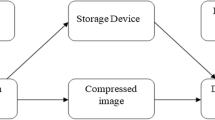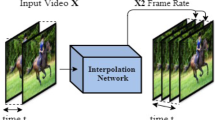Abstract
In this paper, a Context-based 2D Variable Length Coding (C2DVLC) method for coding the transformed residuals in AVS video coding standard is presented. One feature in C2DVLC is the usage of multiple 2D-VLC tables and another feature is the usage of simple Exponential-Golomb codes. C2DVLC employs context-based adaptive multiple table coding to exploit the statistical correlation between DCT coefficients of one block for higher coding efficiency. Exp-Golomb codes are applied to code the pairs of the run-length of zero coefficients and the nonzero coefficient for lower storage requirement. C2DVLC is a low complexity coder in terms of both computational time and memory requirement. The experimental results show that C2DVLC can gain 0.34dB in average for the tested videos when compared with the traditional 2D-VLC coding method like that used in MPEG-2. And compared with CAVLC in H.264/AVC, C2DVLC shows similar coding efficiency.
Similar content being viewed by others
References
Rissanen J. Universal coding, information, prediction, and estimation. IEEE Trans. Inform. Theory, 1984, 30(4): 629–636.
Weinberger M J, Seroussi G, Sapiro G. The LOCO-I lossless image compression algorithm: Principles and standardization into JPEG-LS. IEEE Trans. Image Processing, 2001, 9(8): 1309–1324.
ITU-T. Video coding for low bitrate communications. Version 1, ITU-T Recommendation H.263, 1995.
Marpe D, Schwarz H, Wiegand T. Context-based adaptive binary arithmetic coding in the H.264/AVC video compression standard. IEEE Trans. Circuits Syst. Video Technol., 2003, 13(7): 620–636.
ITU-T. Advanced video coding for generic audiovisual services. Version 1, ITU-T Recommendation H.264, 2003.
Rice R F. Some practical universal noiseless coding techniques—Part I–III. Tech. Rep. JPL-79-22, JPL-83-17, and JPL-91-3, Jet Propulsion Laboratory, Pasadena, CA, Mar. 1979, Mar. 1983, Nov. 1991.
ISO/IEC JTC1. Generic coding of moving pictures and associated audio information—Part 2: Video. ISO/IEC 13818-2 (MPEG-2), 1994.
ISO/IEC JTC1. Coding of audio-visual objects—Part 2: Visual. ISO/IEC 14496-2 (MPEG-4 visual version 1), 1999.
Lakhani G. Optimal Huffman coding of DCT blocks. IEEE Trans. Image Processing, 2004, 14(4): 522–527.
Bjontegaard G, Lillevold K. Context-adaptive VLC (CVLC) coding of coefficients. Joint Video Team of ISO/IEC JTC1/SC29/WG11 & ITU-T SG16/Q.6 Doc., Fairfax, VA, May 2002, JVT-C028.
Au J. Complexity reduction of CAVLC. Joint Video Team of ISO/IEC JTC1/SC29/WG11 & ITU-T SG16/Q.6 Doc., Klagenfurt, Austria, July 2002, JVT-D034.
Final draft of information technology—Advanced coding of audio and video—Part 2: Video. AVS Working Group Doc., Shanghai, China, Sept. 2005, N1214.
Tescher A G, Cox R V. An adaptive transform coding algorithm. In Proc. IEEE XII ICC, June 1976, pp.20–25.
Teuhola J. A compression method for clustered bit-vectors. Inform. Process. Lett., 1978, 7(6): 308–311.
Final draft of information technology—Advanced coding of audio and video—Part 7: Mobile video. AVS Working Group Doc., Shanghai, China, Sept 2005, N1208.
Dong J, Wang J, Yu L. Entropy coding scheme for 4 × 4 residues and improvement for CBP. AVS Working Group Doc., Beijing, China, Nov. 2004, M1455.
Dong J, Lou J, Yu L. Improved entropy coding method. AVS Working Group Doc., Beijing, China, Dec. 2003, M1214.
Wiegand T. Joint final committee draft (JFCD) of joint video specification. Joint Video Team of ISO/IEC JTC1/SC29/WG11 & ITU-T SG16/Q.6 Doc., Klagenfurt, Austria, July 2002, JVT-D157.
Wien M. Variable block-size transforms for H.264/AVC. IEEE Trans. Circuits Syst. Video Technol., 2003, 13(7): 604–613.
Joint Video Team of ITU-T and ISO/IEC JTC 1. Draft ITU-T recommendation and final draft international standard of joint video specification. Joint Video Team of ISO/IEC JTC1/SC29/WG11 & ITU-T SG16/Q.6 Doc., Redmond, WA, July 2004, JVT-L050.
Author information
Authors and Affiliations
Corresponding author
Additional information
Supported by the National Natural Science Foundation of China under Grant No. 60333020 and the Natural Science Foundation of Beijing under Grant No. 4041003.
Qiang Wang received the B.S. and M.S. degrees in computer science and technology from Harbin Institute of Technology (HIT), China, in 2001 and 2003, respectively, where he is currently working toward the Ph.D. degree. Since 2002, he has been with the Joint R&D Lab (JDL), Chinese Academy of Sciences. His research interests mainly focus on image and video compression.
De-Bin Zhao received the B.S., M.S. and Ph.D. degrees in computer science all from Harbin Institute of Technology (HIT), China, in 1985, 1988 and 1998, respectively. After graduated he joined Dept. Computer Science, HIT. He was promoted to associate professor in 1993. Now he is a professor of HIT and Institute of Computing Technology, Chinese Academy of Sciences. He has been a research fellow at Department of Computer Science, City University of Hong Kong. His research interests include multimedia compression and its related applications. He has authored or co-authored over 100 publications.
Wen Gao received the M.S. and Ph.D. degrees in computer science from Harbin Institute of Technology, China, in 1985 and in 1988, respectively, and the Ph.D. degree in electronics engineering from the University of Tokyo, Tokyo, Japan, in 1991. He was a research fellow at Institute of Medical Electronics Engineering, University of Tokyo, Tokyo, Japan, in 1992, and a visiting professor at Robotics Institute, Carnegie Mellon University, Pittsburgh, PA, in 1993. From 1994 to 1995 he was a visiting professor at the MIT AI Lab, Massachusetts Institute of Technology (MIT), Cambridge, MA. Currently, he is the vice president of the University of Science and Technology of China, the deputy president of Graduate University of Chinese Academy of Sciences, professor of Computer Science at Harbin Institute of Technology, and the honor professor in Computer Science at City University of Hong Kong. He is the head of Chinese National Delegation to the MPEG Working Group (ISO/SC29/WG11). He has published seven books and over 400 scientific papers. His research interests are in the areas of signal processing, image and video communication, computer vision, and artificial intelligence. Dr. Gao chairs the Audio Video coding Standard (AVS) working group of China. He is also the Editor-in-Chief of the Chinese Journal of Computers and the general Co-Chair of the IEEE International Conference on Multimodel Interface in 2002.
Rights and permissions
About this article
Cite this article
Wang, Q., Zhao, DB. & Gao, W. Context-Based 2D-VLC Entropy Coder in AVS Video Coding Standard. J Comput Sci Technol 21, 315–322 (2006). https://doi.org/10.1007/s11390-006-0315-2
Received:
Revised:
Issue Date:
DOI: https://doi.org/10.1007/s11390-006-0315-2




